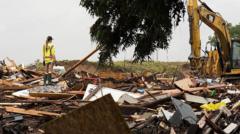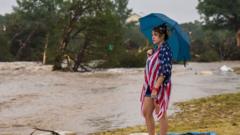Some Democrats attribute the Texas floods' severity to staffing cuts at the National Weather Service, while experts argue that, despite a reduced workforce, forecasts were adequately communicated. This piece explores the nuances of the situation, considering both perspectives and the implications of government efficiency measures.
Assessing the Impact of Government Cuts on Texas Flood Response

Assessing the Impact of Government Cuts on Texas Flood Response
In the wake of devastating floods in Texas, discussions arise regarding potential effects from previous federal workforce cuts under the Trump administration.
The recent catastrophic floods in Texas have reignited debate over the role of government staffing cuts on disaster preparedness and response capabilities. Following the tragic events, notable Democrats, including Connecticut Senator Chris Murphy, indicated that the Trump administration's downsizing of federal meteorological services may have hindered timely weather forecasting and alerts, stating that "Accurate weather forecasting helps avoid fatal disasters."
In contrast, White House Press Secretary Karoline Leavitt countered the allegations, asserting, “These offices [of the National Weather Service] were well staffed… so any claims to the contrary are completely false.” BBC Verify conducted an analysis to uncover the truth behind these claims, diving into both the extent of cuts made and their potential implications.
During Trump's presidency, the administration proposed a significant 25% budget cut to the National Oceanic and Atmospheric Administration (NOAA), which oversees the National Weather Service (NWS). However, these cuts are set to take effect in the 2026 fiscal year and did not contribute to the Texas floods. Instead, reductions initiated due to an efficiency drive led to staffing shortages prior to this event, with about 600 NWS employees among the 4,200 workforce leaving their positions through voluntary redundancies, early retirements, or firings.
While staffing levels dropped, with many NWS offices reportedly unable to fill vacancies at the same rate as a decade ago – some offices observed a vacancy rate of 20% – experts noted that predictions and alerts during the Texas floods were issued accurately and in a timely manner. “The forecasts and warnings all played out in a normal manner,” commented Avantika Gori, a civil and environmental engineering professor at Rice University, emphasizing the difficulty in forecasting extreme localized rainfall events like the floods.
Nonetheless, some experts voiced concerns that the staffing cuts may have affected the efficacy of local NWS offices in coordinating with emergency services, underlining that communication could have been better had those key positions been filled. Relevant vacancies in affected Texas offices, such as a senior hydrologist in San Angelo and a warning coordinating meteorologist in San Antonio, highlight the impact of staffing shortfalls on operational dynamics.
Despite these staffing concerns, the NWS managed to deploy additional forecasters in preparation for the severe weather, demonstrating the agency's intent to mitigate risks during dangerous weather events. Both NWS representatives and President Trump indicated that staffing levels were sufficient, rejecting claims that recent cuts had undermined response measures.
Further complicating the narrative, a significant point of contention emerged regarding the reported reduction in weather balloon launches, crucial for collecting atmospheric data. Meteorologist John Morales highlighted a nationwide 20% decrease in weather balloon launches, alleging a degradation in forecasting quality. However, data indicated that weather balloons had been launched as scheduled in Del Rio, the closest station to the Texas floods, providing relevant information that supported adequate forecasts.
The discussions surrounding the Texas floods exemplify the balancing act between governmental efficiency measures and the need for robust environmental forecasting. As assessments continue, it remains critical to delineate the effects of budgetary decisions from the operational realities of disaster response agencies to inform future policy and ensure public safety.





















